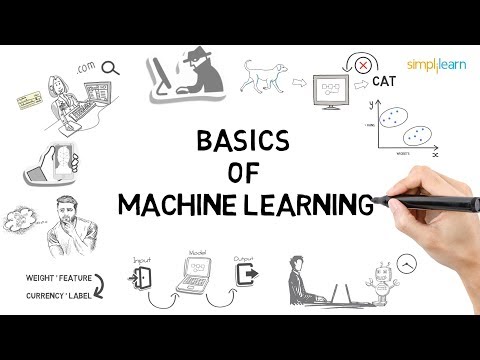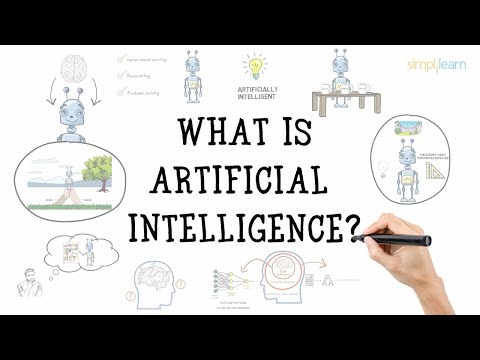This Random Forest Algorithm tutorial will explain how Random Forest algorithm works in Machine Learning. By the end of this video, you will be able to understand what is Machine Learning, what is Classification problem, applications of Random Forest, why we need Random Forest, how it works with simple examples and how to implement Random Forest algorithm in Python.
Below are the topics covered in this Machine Learning tutorial:
1. What is Machine Learning?
2. Applications of Random Forest
3. What is Classification?
4. Why Random Forest?
5. Random Forest and Decision Tree
6. Use case – Iris Flower Analysis
Subscribe to our channel for more Machine Learning Tutorials: https://www.youtube.com/user/Simplilearn?sub_confirmation=1
You can also go through the Slides here: https://goo.gl/K8T4tW
Machine Learning Articles: https://www.simplilearn.com/what-is-artificial-intelligence-and-why-ai-certification-article?utm_campaign=Random-Forest-Tutorial-eM4uJ6XGnSM&utm_medium=Tutorials&utm_source=youtube
To gain in-depth knowledge of Machine Learning, check our Machine Learning certification training course: https://www.simplilearn.com/big-data-and-analytics/machine-learning-certification-training-course?utm_campaign=Random-Forest-Tutorial-eM4uJ6XGnSM&utm_medium=Tutorials&utm_source=youtube
#MachineLearningAlgorithms #Datasciencecourse #DataScience #SimplilearnMachineLearning #MachineLearningCourse
– – – – – – – –
About Simplilearn Machine Learning course:
A form of artificial intelligence, Machine Learning is revolutionizing the world of computing as well as all people’s digital interactions. Machine Learning powers such innovative automated technologies as recommendation engines, facial recognition, fraud protection and even self-driving cars.This Machine Learning course prepares engineers, data scientists and other professionals with knowledge and hands-on skills required for certification and job competency in Machine Learning.
– – – – – – –
Why learn Machine Learning?
Machine Learning is taking over the world- and with that, there is a growing need among companies for professionals to know the ins and outs of Machine Learning
The Machine Learning market size is expected to grow from USD 1.03 Billion in 2016 to USD 8.81 Billion by 2022, at a Compound Annual Growth Rate (CAGR) of 44.1% during the forecast period.
– – – – – –
What skills will you learn from this Machine Learning course?
By the end of this Machine Learning course, you will be able to:
1. Master the concepts of supervised, unsupervised and reinforcement learning concepts and modeling.
2. Gain practical mastery over principles, algorithms, and applications of Machine Learning through a hands-on approach which includes working on 28 projects and one capstone project.
3. Acquire thorough knowledge of the mathematical and heuristic aspects of Machine Learning.
4. Understand the concepts and operation of support vector machines, kernel SVM, naive Bayes, decision tree classifier, random forest classifier, logistic regression, K-nearest neighbors, K-means clustering and more.
5. Be able to model a wide variety of robust Machine Learning algorithms including deep learning, clustering, and recommendation systems
– – – – – – –
Who should take this Machine Learning Training Course?
We recommend this Machine Learning training course for the following professionals in particular:
1. Developers aspiring to be a data scientist or Machine Learning engineer
2. Information architects who want to gain expertise in Machine Learning algorithms
3. Analytics professionals who want to work in Machine Learning or artificial intelligence
4. Graduates looking to build a career in data science and Machine Learning
– – – – – –
For more updates on courses and tips follow us on:
– Facebook: https://www.facebook.com/Simplilearn
– Twitter: https://twitter.com/simplilearn
– LinkedIn: https://www.linkedin.com/company/simplilearn
– Website: https://www.simplilearn.com
Get the Android app: http://bit.ly/1WlVo4u
Get the iOS app: http://apple.co/1HIO5J0
Similar Posts:
-

Machine Learning Tutorial | Machine Learning Basics | Machine Learning Algorithms | Simplilearn -

Machine Learning Basics | What Is Machine Learning? | Introduction To Machine Learning | Simplilearn -

Supervised and Unsupervised Learning In Machine Learning | Machine Learning Tutorial | Simplilearn -

Artificial Intelligence In 5 Minutes | What Is Artificial Intelligence? | AI Explained | Simplilearn

Leave a Reply